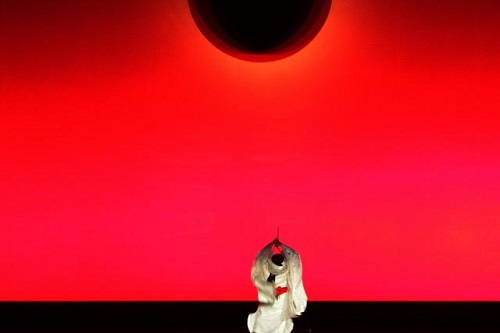 Poland Puccini, Madama Butterfly: Soloists, Chorus and Orchestra of the Teatr Wielki / Piotr Staniszewski (conductor), Polish National Opera, Moniuszko Auditorium, Teatr Wielki, Warsaw 19.5.2018. (RP)
Poland Puccini, Madama Butterfly: Soloists, Chorus and Orchestra of the Teatr Wielki / Piotr Staniszewski (conductor), Polish National Opera, Moniuszko Auditorium, Teatr Wielki, Warsaw 19.5.2018. (RP)

Cast:
Madama Butterfly – Karah Song
Suzuki – Agata Schmidt
Pinkerton – Tadeusz Szlenkier
Sharpless – Tomasz Rak
Goro – Mates Zajdel
Kate Pinkerton – Aleksandra Orłowska-Jabłońska
Yamadori – Piotr Maciejowski
The Bonze – Mieczysław Milun
The Imperial Commissioner – Mateusz Stachura
Production:
Director – Mariusz Treliński
Set Designer – Boris Kudlička
Lighting Designer – Stanisław Zięba
Costume Designers – Paweł Grabarczyk & Magdalena Tesławska
Chorus Master – Mirosław Janowski
This was my first time experiencing Mariusz Treliński’s much praised and well-traveled production of Madama Butterfly. Eschewing the temptation to reproduce traditional Japanese scenes, Treliński instead created two worlds: the first, minimalist in design and awash in color, and another dominated by oversized, stylized Japanese symbols and elements. It is a staging that contains some of the most beautiful, powerful scenes that I have ever seen in a theater.
The most potent ones were those of the child bride’s arrival with her entourage in Act I as Pinkerton stood mesmerized at the sight of his veiled bride floating towards him; and in the final moments of the opera when Cio-Cio-San, silhouetted by the blazing sun, drives her father’s sword into her body. In both scenes the stage was awash in red, but in the former the color created an exotic atmosphere of anticipation and sensuality, while in the latter it was one of desperation and tragedy.
Treliński used other colors just as effectively, but his palette was limited. The daytime skies were a transparent azure hue, while those of the night were a velvety dark blue with fishing boats and their lanterns gliding across the stage. The ladies who accompany Cio-Cio-San to her wedding wore lustrous purple kimonos, wielding fans of the same color that telegraphed their every emotion. White also featured prominently.
The interior scenes of the second act are bathed in a softer yellow glow of aged bamboo. Massive walls were fabricated out of stone slabs, rows of Buddhas in alcoves and Japanese texts. The Niō, the two wrathful and muscular temple guardians of the Buddha, also make their appearance.
The costumes were high-fashion, stylized adaptations of traditional attire of the period, both Japanese and Western. Kate Pinkerton’s remarkable dress and veil were more from the world of architecture than fashion. Her severe look, complete with riding crop, telegraphed that a much different life awaited Pinkerton back in America.
The staging was rich in details: the snap of a fan and a harsh look from each of women rebuking Butterfly after the Bonze denounced her, the arms of the Buddha statues that suddenly come to life and strew cherry blossoms, the intricate movements perfectly synchronized with the music.
In lesser hands, the strong visual images and introduction of new elements, such as Cio-Cio-San’s mute, spectral mother and three male dancers, would have been overwhelming. Treliński, however, avoided the pitfalls and instead created a backdrop that focused all attention on the teenage girl whose love for a foreigner caused her to forsake the past, except for her strict adherence to the uncompromising code of honor instilled in her from birth.
Karah Song’s Butterfly was an exquisitely crafted character. Visually, she was perfect, and while her voice lacks the power to give full vent to Butterfly’s passions and ride over Puccini’s orchestrations, it mattered little as conductor Piotr Staniszewski was always attentive to balance. If her ‘Un bel di vedremo’ lacked a certain spaciousness and bloom, her searing ‘Tu? Tu? Piccolo iddio!’ was everything that one could hope for.
Tadeusz Szlenkier had the essential elements for Pinkerton: a gleaming voice, a carefree attitude and robust good looks. He sang Pinkerton’s Act I aria, ‘Dovunque al mondo lo Yankee vagabondo’, with almost reckless abandon, but by the Love Duet his characterization and voice had changed. He was intoxicated by Butterfly’s beauty and youth, and his sound became more focused, almost silvery.
Agata Schmidt’s mezzo-soprano wants to soar. As Suzuki, she was careful to never overpower her Butterfly – in fact their voices blended together quite well – but given the chance her voice simply bloomed. Staniszewski knew this, letting the orchestra swell to support her when the opportunity arose, and in Act III he conducted with abandon as she and Szlenkier poured out the sound.
The rest of the cast was equally strong. Tomasz Rak’s Sharpless was stolid and firmly voiced. Mates Zajdel was lithe and agile as Goro, whom Treliński envisioned as a Wagoto character from traditional kubuki theater. Prince Yamadori, sung by Piotr Maciejowski, was conceived as a potentate seated on a massive throne, ornately costumed and with finger nails several inches long. Mateusz Stachura, a fine young baritone, completed the cast as the Imperial Commissioner.
Staniszewski’s reading of the score was rich in detail. The orchestra was at its best in Act III as it pared down the expansive, throbbing sound that underpinned the passionate exchange between Suzuki and Pinkerton to an ever more focused core, which suddenly burst forth in the opera’s final measures. The chorus too did fine work, the women especially effective in the ‘Humming Chorus’ of the second act.
That a production almost 20 years old is still so potent, is nothing less than remarkable.
Rick Perdian
Thanks – I had heard of this production. Now I understand why it impressed so many people.